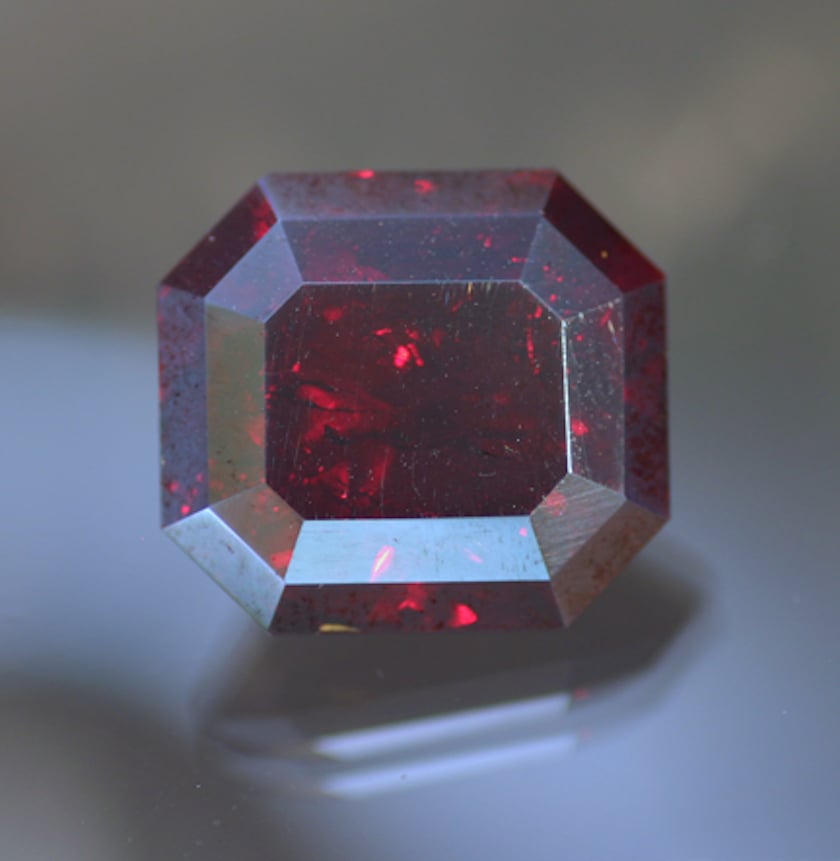What are Allochromatic and Idiochromatic Gems?
Learn the difference between allochromatic and idiochromatic gems and why some gem species can occur in many color varieties and others occur only in one.
3 Minute Read
What Causes Gemstone Color?
Elements and Gemstone Color
The elements in a gemstone can affect the color we perceive. In gemstones, two large groups of elements can absorb visible light.
- The transition metal group includes elements such as chromium, copper, gold, iron, and nickel.
- The rare earth series contains elements such as gadolinium, erbium, and yttrium.
The light spectra not absorbed by the gemstone are transmitted or reflected back to the viewer. We see these wavelengths of light and process them as color.
Interested in this topic?
This article is also a part of our Amethyst Specialist Mini Course, in the unit Introduction to Amethyst.
Other Influences on Gemstone Color
Other factors besides absorption can affect the gem color viewers see. These may include:
- Defects in crystal structure
- The lengths that rays of light travel through a gem
- Differing light sources, such as daylight, fluorescent, etc.
- Natural radiation
In addition, gemstone phenomenal effects, such as play of color and iridescence, may show colors. Reflections from inclusions inside of gems can also create color effects such as the aventurescence of aventurine and the schiller of sunstone.
Gemstone treatments can also affect gem color. These may include:
Impurities or Essential Elements?
Some elements are impurities within a gem; others are essential components of a gemstone's chemistry. Impurities and essential elements play different roles in gemstone coloration.
Allochromatic Gems
Some gems contain traces or "impurities" of light absorbing elements that act as chromophores. They aren't essential parts of gemstone chemical structure, but nonetheless play a key role in coloration. Gems that receive their color from impurities are known as allochromatic. In their pure state, these gems would be colorless.
Idiochromatic Gems
On the other hand, some gems contain color-causing elements that are essential to their chemical structure. These are known as idiochromatic gems. Such gems are never found colorless. The coloring elements are essential to their composition as unique gem species.
While allochromatic gems may occur in various colors due to the presence of different trace elements, idiochromatic gems only occur in a single color.
Examples of Allochromatic Gems
Most well-known jewelry gemstones, including quartz, spinel, topaz, and tourmaline, are allochromatic. Let's take a closer look at the beryl family, which includes many popular allochromatic gems.
The beryl family includes gem varieties such as green emerald, pink morganite, and blue to blue-green aquamarine. The chemical formula for all these varieties of beryl remains the same: Be3Al2Si6O18. Trace elements in beryls create these color varieties. Thus, beryl is allochromatic.
- Without any trace elements, beryl would appear colorless, a variety known as goshenite.
- Chromium (Cr), vanadium (V), and/or iron (Fe) creates green for emeralds.
- Manganese (Mn) creates the pink of morganite.
- Iron colors aquamarine.
Do Trace Elements Always Cause the Same Colors in Allochromatic Gems?
The presence of the same trace element in different allochromatic gems doesn't necessarily cause the same color effect. For example:
- Chromium traces in beryl make emeralds green
- In corundum (Al2O3), chromium traces create the red color of rubies
(Pure corundum is colorless. Other impurities in corundum cause the many colored varieties of sapphire).
Although an allochromatic gem's coloring agent is a trace element, other factors can still affect the color viewers see. For example, iron's oxidation state can affect the color it imparts.
- Ferrous iron (Fe2+) usually gives a blue or green color.
- Ferric iron (Fe3+) usually gives a yellow or brown color.
(The oxidation state affects how iron bonds to neighboring atoms in the crystal).
Examples of Idiochromatic Gems
Some gems occur in only one color. For example, malachite is invariably green. The element copper (Cu), its coloring agent, is an essential component of its chemical formula: Cu2CO3(OH)2. Thus, malachites are idiochromatic gems.
Do Essential Elements Always Cause the Same Colors in Idiochromatic Gems?
The presence of the same essential element in different idiochromatic gems doesn't necessarily impart the same color. For example:
- Copper causes a red color in the rare gemstone cuprite (Cu2O)
- Copper causes a blue color in turquoise (CuAl6(PO4)4(OH)8·4H2O)
Just as in allochromatic gems, other factors in addition to the coloring agent can affect the color we can see in idiochromatic gems.
Donald Clark, CSM IMG
Donald Clark, CSM founded the International Gem Society in 1998. Donald started in the gem and jewelry industry in 1976. He received his formal gemology training from the Gemological Institute of America (GIA) and the American Society of Gemcutters (ASG). The letters “CSM” after his name stood for Certified Supreme Master Gemcutter, a designation of Wykoff’s ASG which has often been referred to as the doctorate of gem cutting. The American Society of Gemcutters only had 54 people reach this level. Along with dozens of articles for leading trade magazines, Donald authored the book “Modern Faceting, the Easy Way.”
International Gem Society
Related Articles
What’s the Difference Between Rubies and Pink Sapphires?
South Sea Pearls: the Complete Guide
Jade Color Trade Names
IGS Certification Exam: Sample Gemology Questions
Latest Articles
Opal Buying Guide
Amethyst Sources Around the World: The Geological Story Behind These Purple Gemstones
Brazilianite Value, Price, and Jewelry Information
Ruby-Glass Composites vs Leaded Glass Clarity Enhancements
Never Stop Learning
When you join the IGS community, you get trusted diamond & gemstone information when you need it.
Get Gemology Insights
Get started with the International Gem Society’s free guide to gemstone identification. Join our weekly newsletter & get a free copy of the Gem ID Checklist!
